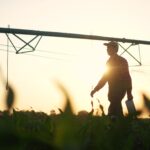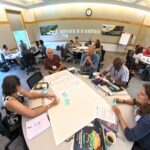While world leaders met in New York at the United Nations General Assembly earlier this year, philanthropists also converged on the city to figure out how to leverage their collective power to support local and systemic solutions to urgent global crises. From exploring what it takes to fund systems change to accelerating food systems transformation and supporting locally-led development, dozens of philanthropies voiced their commitment to catalyzing sustainable change.
One of the most exciting meetings involved 21 representatives from 16 philanthropies, impact investors, and nonprofit partners who discussed working together to drive finance to integrated landscape initiatives. EcoAgriculture Partners and EIT-Climate-KIC organized the event, Philanthropic Action for Thriving Landscapes, on behalf of the 1000 Landscapes for 1 Billion People (1000L) initiative on September 19, 2023. CDP North America hosted at its New York City offices.
Throughout the two-hour discussion, leaders from the BHP Foundation, the IKEA Foundation, Laudes Foundation, the Rockefeller Foundation, and the Target Foundation, among others, discussed ways to align their separate funding to back integrated landscape initiative portfolios and multiply and sustain their impact. They agreed they could leverage bigger pools of capital from other private and public sources by collaborating. Working together, they decided, would be the most efficient way of addressing growing crises such as landscape degradation, poverty, inequality, and the looming climate disaster.
Kirsten Dunlop, CEO of EIT Climate-KIC and co-organizer of the dialogue, emphasized the significance of coordinated funding. “Public, private, and philanthropic funding working together can make all the difference to lift ambition, create leverage, and build momentum for transformation in landscapes and beyond,” she said. “This is essential if we are to stand a chance of achieving the structural, systemic, institutional change that we so urgently need.”
Top insights from the dialogue include:
Philanthropy can unlock landscape finance at scale. Philanthropies should collaborate to support efforts to identify and implement strategies to catalyze more significant public and private finance flows to landscapes. This work could include uniting a community of landscape finance experts, supporting strategic alignment around risk and associated capital sources, and reimagining existing financial mechanisms for landscape use.
Landscape partnerships receive vital support from philanthropy. Landscape partnerships undertake long, politically complicated processes of developing trust, common understanding, shared visions, action plans, and financing strategies amongst diverse stakeholders. Despite their complexity, landscape partnerships ensure collective buy-in and sustained landscape transformation. Philanthropies provide essential support for landscape partnerships and can do so over the long term through collaborative funding models.
Landscape finance contributes to fair outcomes. Environment and livelihoods are interlinked issues that philanthropies must address together to generate equitable benefits. Integrated landscape approaches give smallholders, local communities, and Indigenous people a voice and power in decision-making and planning over collective resources. Landscape finance mechanisms can channel funds from large companies, carbon emitters, and finance institutions to support their plans.
Philanthropy can generate collaboration with businesses in landscapes. Companies are increasingly interested in adding landscape development into their value chains to meet sustainability objectives and reduce risk. Philanthropy can motivate more commercial investment that aligns with locally defined strategies.
Robust landscape finance case studies are essential. Building the foundation to scale landscape finance requires convincing stories and case studies for different audiences. Studies should address the business case for landscape investments, their positive impacts on people, nature, and the climate, and evidence of the effects of patient investments.
Reflecting upon the discussion, Amol Mehra, Laudes Foundation’s director of industry programs, said, “Regenerative production landscapes hold tremendous promise in driving meaningful impacts for climate goals while centering the agency and inclusion of smallholders and producers. We are already seeing this promise turn into practice thanks to the efforts of organizations like 1000L and EIT-Climate-KIC. What’s needed now is focused investment to mainstream landscapes. Philanthropy has an important role here to help pave the way for public- and private-sector investment to follow.”
For more detailed findings from the dialogue, see the full report, Philanthropic Action for Thriving Landscapes: Notes and Ideas for Action.


